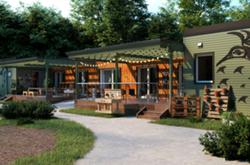
When a team of conservationists and guides set out to explore Edouard Pass in B.C.'s central Purcell Mountains they intended to document the landscape and wildlife as it exists today.
Gary Diers rhymes off a list of animals they spotted: "golden eagle, mountain goats, caribou, small mammals, lots of birds ... we just shook our heads when we got there, it's a completely pristine area."
He and other members of the Wilderness Committee, which funded the expedition, fear it might not remain so pristine for long.
A 125 megawatt run-of-river hydro project in the area is currently in the environmental assessment process. The proponent, Purcell Green Power Inc., intends to build two facilities that would divert water from Glacier and Howser creeks, approximately 50 kilometres south-west of Invermere.
A 90-kilometer-long transmission line would cross the Purcell Mountains and connect at the Invermere sub-station.
"From the south end of Purcell wilderness conservatory, all the way to the TransCanada Highway, there is no industrial development," says Diers. "With a transmission line like this and assisting roads, no longer will it be a pristine corridor."
66 run-of-river projects in the works
Although the provincial government is promoting run-of-river as a clean, green source of power, critics say the speedy development of this industry, coupled with weak wildlife legislation, is destroying the landscape of B.C.'s back country and endangering wildlife there.
The Glacier-Howser project is just one of many run-of-river projects in some stage of development in the province. According to a recent report by Watershed Watch Salmon Society, some 25 such projects were approved before 2006, 41 have since received initial approval from BC Hydro and hundreds more water license claims have been made on rivers across the province.
The impact of a single project, let alone all of them together, reaches far beyond rivers, tributaries and the fish species in those waterways.
Part and parcel with hydro development, particularly in remote areas of the province, are transmission line corridors and access roads, sometimes totalling hundreds of kilometres in length.
"Just the existence of transmission lines themselves can sometimes interfere with the movements of wildlife, particularly animals that like to stick to dense cover," says biologist and environmental consultant Lee Harding. He says for grizzly bears, this development represents a loss of habitat because they might not cross such open corridors.
Importing human beings
Harding adds that other species, like caribou and moose, "can live quite happily with transmission lines in their area," but that doesn't mean those species are safe from what access roads and transmission lines bring in -- humans.
"The worst thing ... is generally the access that they give to hunters and recreationists who use powered vehicles. That's the worst impact," says Harding.
This is the kind of impact that worries Elaine Golds, conservation chair of the Burke Mountain Naturalists, a group that has taken up the fight against Run of River Power Inc.'s Upper Pitt River development.
It includes seven interconnected hydro projects on eight of the river's tributaries as well as two transmission line options, each between 42 and 53 kilometres in length and each bisecting part of Pinecone Burke Provincial Park.
"We campaigned mightily to get Pinecone Burke protected in 1995," says Golds.
"We think it's an absolutely spectacular wilderness ... it's amazing that we have an area like this so close and it's because you can't drive there, you can only get in by boat."
"This is a new intrusion into a remote wilderness area," Golds says.
'Hinterlands open for business'
Mark Haddock, a lawyer who received funding from West Coast Environmental Law to work with the Burke Mountain Naturalists, said most wildlife habitat protection measures were enacted with the forestry industry in mind. Now, IPPs are going where logging companies can't (mostly because the areas aren't profitable to log) and the same rules don't apply to them.
"B.C.'s hinterlands are opened up for business," says Haddock. "And there's a huge impact on the environment and wildlife that's not getting properly assessed."
For example, when a proponent applies for a water license, it must assess present fish populations, and how the project could affect those populations. Under the fish protection act, there are rules that set out the parameters for those assessments.
No such guidelines exist for other mammal, bird, insect or amphibian species.
"We have guidelines that we wish proponents to follow when they do an assessment of potential impacts to fisheries, but we don't have any guidelines at this time for proponents when assessing impacts to wildlife or any other non-fish species," says Ross Neuman, head of the ecosystems section of the Ministry of Environment's environmental stewardship division.
Neuman says the lack of ministry guidelines for non-fish species has been identified as a gap, but adds that such guidelines are not currently in production and are not being addressed in the ministry's current revision of the B.C. Wildlife Act (to be released early in 2008).
Still 'building the policy'
Steward Guy, manager of the ministry's conservation planning sector in Victoria, says the ministry is in policy discussion right now.
He says independent power production "is raising a whole new way for us to consider how we place environmental protection. We're building the policy with how we deal with new initiatives around the British Columbia."
"There are two aspects of most environmental legislation; the rules and procedures about how to undertake approvals, and the substance of protection for the environment," says Haddock.
Wildlife is addressed procedurally in other approvals, he says, but there is no strong legislation to make sure proponents effectively measure potential impacts and mitigate them.
Gap in wildlife assessments
When an IPP wants to develop a new hydro project, it must obtain licenses under the B.C. water act and land act, and comply with legislation under both provincial and federal fish protection acts and environmental assessment acts, among others.
These are legally binding, and these agency offices get to make the decision about whether or not to issue the license or environmental assessment certificate.
Environmental stewardship is the agency charged with protecting wildlife and wildlife habitat, but its role in the approval process is simply to guide other decision-makers.
Proponents are not required to give environmental stewardship officers requested studies, and this "gap" in wildlife assessment guidelines means the scope and depth of any proponent study can vary widely from project to project.
"If the level of work that's done does not provide us with adequate information to enable us to advise the decision maker as to the potential impacts and risks ... it's up to the decision maker to get back to the proponent and say, well you have to do more work, or to make a decision without the benefit of our advice," says Neuman.
"But we have no authority to insist either that they even use the guidelines, or that they do a piece of work that we find satisfactory."
Self-policing process
Haddock says that even with the conditions and regulations currently in place, there is another gap in making sure proponents are carrying them out as required.
He says, that in his own discussions with government officials, he's detected "a broad acknowledgement of a lack of follow-up," when it comes to monitoring the conditions placed on approvals.
For example, a proponent might be issued an environmental assessment certificate on the conditions they monitor grizzly bear activity in the transmission line area. Haddock says this kind of information is too reliant on experts who are on the payroll of the proponent.
"There's been so many cuts to the ministry of environment that there's very little ability to do any field review," he says. "It's all highly reliant on the proponent's own experts."
Neuman says he is one of 11 people in the ministry's Lower Mainland office who provide input for environment assessments. He says this represents "quite a significant workload," but it's just one small piece of what they do.
"All of these people do lots of other things at the same time. We don't have anybody where 'your job is to deal with IPPs and nothing else,'" he says. "Resources is always a challenge."
Related Tyee stories:
- A 'Green' Threat to B.C.'s Rivers?
Touted by BCHydro as renewable electricity, the rush to install privatized 'micro-hydro' schemes may change the flow of 76 B.C. rivers. - BC Hydro's Amazingly Bad Deal for Ratepayers
We give big firms $15 billion. We get higher prices, no assets, no guarantee of supply. - BC's Billion-Dollar Wind Power Giveaway
We're heavily subsidizing private power developers. Will Californians profit big?
















Tyee Commenting Guidelines
Comments that violate guidelines risk being deleted, and violations may result in a temporary or permanent user ban. Maintain the spirit of good conversation to stay in the discussion.
*Please note The Tyee is not a forum for spreading misinformation about COVID-19, denying its existence or minimizing its risk to public health.
Do:
Do not: